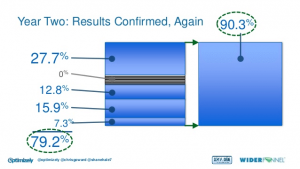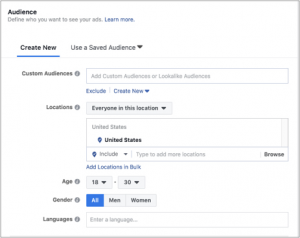As a marketer, you’ve got a lot on your to-do list. Even if you focus on just one or a few sub-goals at a time, there are overarching goals that every marketer needs to solve for at all times. For example:
- How can you generate more high-quality leads for your sales team?
- Can you assist the sales team in converting those leads into new customers?
- What can you do to increase customer retention?
- How do you keep growing your business blog to get more subscribers?
Luckily, email marketing can help with every single one of these.
Yet when you ask a marketer how effective their email marketing is, they’ll probably tell you their average click-through rate. Maybe they’ll mention their latest open rates, too.
Don’t get me wrong – these are important metrics for determining the performance of your individual emails. But is this really how we marketers should be defining the effectiveness of our email efforts?
I certainly don’t think so, and for one main reason: There’s a difference between measuring performance and measuring impact.
Today I want to talk about the latter of these. In the end, a high click-through rate isn’t going to change your business, but impactful email campaigns that help and delight your customers…well, that just might.
4 Metrics To Measure The Impact Of Your Email Marketing
As I hinted above, strengthening your email marketing channel optimizes every part of your funnel. Let’s take a look at how to leverage your email for some of these high-level goals:
1. Grow Your Subscriber List
Your Goal: The very top of the marketing funnel is all about driving awareness, i.e., bringing new eyeballs to your blog or website. And if you know anything about content marketing, then you know that shareable, engaging content is key to generating this sort of awareness.
If you have a business blog, for example, one of your top-of-the-funnel goals should be growing your blog subscribers. The more subscribers you have, the bigger your email list, right? Plus, you stand to gain even more readers when subscribers share your content with friends and colleagues.
How Email Marketing Helps: First off, email should be your main tool for sending blog content to subscribers. However, you can also use email marketing to grow your subscriber list by emailing contacts who found you on other channels, downloaded one of your eBooks or registered to attend one of your webinars. These folks are interested in consuming content relevant to your industry, so why not deliver daily or weekly content straight to their inboxes?
Metric To Measure: Number of new blog subscribers generated through email marketing.
2. Generate Leads
Your Goal: The next stage of the marketing funnel focuses on generating leads. If you have a sales team, you know all too well that they’re constantly aching for new qualified leads. So, how do you go about generating leads from your email marketing?
How Email Marketing Helps: Chances are, the folks in your contacts database are either blog subscribers or leads.
If they’re blog subscribers, one of your primary goals (aside from delighting them with helpful, relevant content) should be converting them into leads. You can do this by emailing them lead gen-focused content. (For example, “If you enjoyed this blog post about getting started with social media, you’ll love our free eBook on using Facebook ads for business!”) You can also include calls-to-action within blog posts that will encourage readers to download an eBook or other relevant piece of content.
For the folks who are already leads, you should encourage them to forward your emails or lead gen content to friends and colleagues. By creating more email forwards and social shares, you’ll expand your audience, drive more downloads and of course, generate new leads for the funnel.
Metric To Measure: Number of new leads generated through email marketing.
3. Convert Leads Into Customers
Your Goal: In the middle of the funnel, you should focus on converting your leads into customers. If you have a sales team, you might be tempted to say that it is 100 percent on them to close customers. However, your job as a marketer is to make it as easy as possible for your sales reps to do this.
Note: If you don’t have a sales team, it’s actually even more important to create email marketing that will drive customers to purchase.
How Email Marketing Helps: Email marketing is a fantastic lead nurturing tool, yet is drastically underutilized as such. In other words, if you’re not using email to educate leads about your industry, product or service, now is the time to start.
Before you design the actual emails themselves, sit down and map out the flow of your nurturing series. Ask yourself: What segment of my list will this particular nurturing series target? What content can I include in my emails to help this group achieve their specific goals? How can I educate this audience about product features that are most helpful and relevant to them?
Once you’ve mapped out audience segments and content for each nurturing series, design your emails (optimizing for clicks and conversions, as always) and use a marketing automation tool like MailChimp, HubSpot, or Pardot to schedule your emails to trigger over the course of several days or weeks.
Metric To Measure: Overall lead-to-customer conversion rate. If you want to get even more granular, track lead-to-customer conversion rate just for leads enrolled in your lead nurturing series.
4. Delight Customers
Your Goal: Even after the sales cycle is complete, your job as a marketer continues. In fact, customer marketing is one of the most important tools for increasing customer retention and reducing churn rates.
Of course, this job falls on the shoulders of many: Your customer support representatives must solve issues quickly, your product team must build features that make your customers’ lives easier and your sales team must upsell customers on upgrade features.
As a marketer, it’s your job to be the voice of that overall business, and customer delight is a core part of that.
How Email Marketing Helps: Email isn’t just a tool for generating leads and pitching your product – it’s also a tool for communicating. Use it to keep your customers happy and loyal.
For example, let them be the first to know when new features are rolled out. Send them tutorial videos to help onboard them quickly. You can even set up a customer blog and create content designed specifically to help them learn more about your industry and product. Heck, just send them a fun email on their birthday!
The point is, you should always be asking yourself, “What can I do to make our customers smile?” That should be a good starting point.
Metric To Measure: Customer retention or customer churn rate.
By looking at these impact metrics, you’ll be able to combine two important views: a data-driven view that looks at the numeric values of email metrics, plus a unified view that surveys all of your metrics together and harnesses the power they have to make or break your business.
So remember: Next time you craft an email, don’t think of it as one email in a silo. Definitely don’t get hung up on click-through rate, the call-to-action button or even the subject line you went back and forth on a dozen times. Instead, ask yourself what impact this email will have. Then it’s time to read that email again.
We’ve got you covered when it comes to email marketing. Check out our tips for crafting the most terrible email possible, how to drive engagement in your newsletters, and how to write email content that clicks.
(172)






